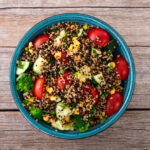by: November 12, 2024
 (NaturalHealth365) Nonalcoholic fatty liver disease, or NAFLD, is a massive problem in the Western world, with over 25% of the population likely being affected. The disease often has few symptoms until it progresses. Fatty liver symptoms can include chronic fatigue, abdominal swelling, full-body itching, shortness of breath, and other issues. If left untreated, NAFLD can progress into a type of nonalcoholic cirrhosis or steatosis.
(NaturalHealth365) Nonalcoholic fatty liver disease, or NAFLD, is a massive problem in the Western world, with over 25% of the population likely being affected. The disease often has few symptoms until it progresses. Fatty liver symptoms can include chronic fatigue, abdominal swelling, full-body itching, shortness of breath, and other issues. If left untreated, NAFLD can progress into a type of nonalcoholic cirrhosis or steatosis.
NAFLD is a byproduct of rampant metabolic syndrome, type 2 diabetes, and so the cause is almost always a standard American diet. While it should come as no surprise to most people that a healthy, whole-food diet is the solution to most modern metabolic health problems, scientists are looking at ways to utilize whole foods as a targeted biological medication for conditions like NAFLD. One such study looked at the usefulness of quinoa extracts in treating fatty liver disease because there aren’t any effective conventional treatment options for fatty liver.
Let’s look at the study and what it can mean for those suffering from NAFLD and if there’s anything you can do at home to mimic the benefits of the study.
What is nonalcoholic fatty liver disease?
Nonalcoholic fatty liver disease (NAFLD) occurs when our bodies store excess calories, especially from triglycerides and sugars, as fat in the liver. Since the liver isn’t meant to store large amounts of fat, this accumulation can impair its normal functions.
NAFLD is closely linked to metabolic disorders like type 2 diabetes and obesity. This creates a challenging cycle: metabolic issues can contribute to fatty liver, worsening metabolic health. If left untreated, this condition can progress to liver scarring (cirrhosis) and, in severe cases, lead to liver failure.
The prevalence of NAFLD has increased significantly in recent decades, largely due to changes in dietary patterns and lifestyle. Many people are surprised to learn that the fat accumulation in NAFLD is somewhat similar to what happens in foie gras production, where ducks or geese are intentionally overfed to create a fatty liver – though, of course, in humans, this happens unintentionally through our regular diet and lifestyle choices.
Is quinoa beneficial for fatty liver disease?
Researchers in the study recognized the benefits of plant-based polyphenols within quinoa, specifically for reducing inflammation and fat accumulation. For this reason, they decided to study the effects of concentrated quinoa compounds on fatty liver disease.
By extracting fatty hepatic cells and exposing them to quinoa polyphenol extract or QPE, researchers could gauge whether or not there was any measurable benefit from the quinoa extract.
The steady results were remarkable in four key areas.
Reduction of liver fat
The QPE reduced the fat content of the hepatic cells, primarily in the form of triglycerides and cholesterol. This is critically important because, as we stated before, metabolic disease and NAFLD are made worse by their very existence. Excess fat makes metabolic disease worse, which makes NAFLD worse, and fat accumulation gets worse.
Reduced inflammation
The QPE reduces overall inflammation in the cells because the polyphenols in quinoa, when eaten as a food, are known to increase antioxidants in the body, which protects cells and staves off inflammation and damage.
Improved antioxidant production
In addition to introducing exotic antioxidants to the body, the quinoa extract also helps the body produce more antioxidants on its own, further shielding cells from oxidative stress.
Reduced fat production in the liver
The quinoa extract also seemed to dramatically slow fat production within the liver cells. This is important as it impedes the progress of metabolic disease and the accumulation of fat within the liver organ, contributing to NAFLD.
Quinoa: So much more than a rice substitute
If you’re new to quinoa (pronounced “keen-wah”), you’re about to discover a fascinating food that’s technically not a grain at all. It’s actually a pseudocereal – more closely related to seeds than to traditional cereal grains like wheat or oats. Native to South America, quinoa has been a dietary staple for thousands of years and has gained worldwide recognition for its impressive nutritional profile.
What makes quinoa special? It’s packed with complex carbohydrates, antioxidants, healthy fats, and fiber. Plus, it’s one of the few plant foods that provides all essential amino acids, making it a complete protein source.
Here’s how you can incorporate it into your meals:
- As a rice substitute in main dishes, it easily absorbs the flavors of your favorite seasonings
- In breakfast bowls, similar to how you’d use oatmeal, topped with fruit, nuts, and a drizzle of honey or maple syrup
- Ground into flour for baking or as a protein boost in smoothies
You can find quinoa in most grocery stores, making it easily accessible for anyone looking to diversify their diet. Whether focusing on improving your nutrition or wanting to try something new, quinoa offers a hearty flavor and impressive nutritional benefits that make it worth adding to your pantry.
Editor’s note: Discover the best ways to eliminate the threat of fatty liver disease, own the Fatty Liver Docu-Class created by NaturalHealth365 Programs.
Sources for this article include:
No hay comentarios:
Publicar un comentario